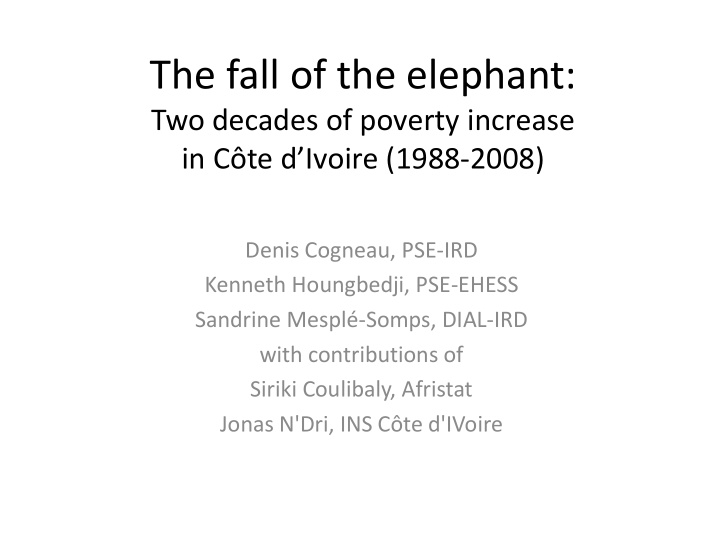



The fall of the elephant: Two decades of poverty increase in Côte d’Ivoire (1988-2008) Denis Cogneau, PSE-IRD Kenneth Houngbedji, PSE-EHESS Sandrine Mesplé-Somps, DIAL-IRD with contributions of Siriki Coulibaly, Afristat Jonas N'Dri, INS Côte d'IVoire
Boom and crisis Following the end of the cocoa boom, and 3rd SAP, the golden age was already past in 1988...
Nine decades ago…
Cash crop story After 1988, cash crops still over-determine the story: - international prices / producer prices - output (forest & investment in cocoa trees) - fiscal income public wages & expenditures - even with civil war & partition: coastal Sth producing cocoa, landlocked Nth producing cotton Secondary determinants: foreign aid inflows + oil (since mid-2000s)
1988-2011 1988-1993: Cocoa crisis 750 200 180 1994-1999: 700 160 140 650 120 CFAF deval. 100 600 80 short-lived 60 bounce-back 550 40 20 500 0 2000-2011: GDP per capita (constant 2000 USD) Cocoa+Coffee+Cotton output per capita at int. prices (GDP deflator; 2000 USD) Civil conflict at Crude oil output per capita at int. prices (GDP deflator; 2000 USD) intervals
Real producer prices 12 3.5 3 10 2.5 8 2 6 1.5 4 1 2 0.5 0 0 1988 1989 1990 1991 1992 1993 1994 1995 1996 1997 1998 1999 2000 2001 2002 2003 2004 2005 2006 2007 2008 Real producer price cocoa (CPI deflated; 2000 USD) Real producer price coffee (CPI deflated; 2000 USD) Real producer price cotton (CPI deflated; 2000 USD) : right scale
In short: 1988 → 1993: Halving of cocoa/coffee prod. prices + large cuts in public expenditures (Dec. 1993: Death of Houphouet-Boigny) 1994 1998: Devaluation bounce back. Aid ↑ Liberalization without progress in rule of law “12 works of the elephant of Africa” 1998 2002: Disillusion + Stagnation. Cocoa ouput no longer growing. Aid ↓ 2002 2008: Civil war, N-S partition of the country, stagnation in the Sth, P0 +22 pp in the Nth
See also Dabalen & Saumik (2013) + Beegle et al. (2012)
Before and after cocoa crisis
Headcount (1.25 int. 2005$) 70% 60% 50% 40% 30% 20% 10% 1988 1993 1998 2002 2008 National North South
Despite the crisis... Accumulation of durable goods, whose relative prices decrease After a drop in 1988-93, primary school enrollment recovered (but not to 1988 levels)
Issues ahead (1) Whither reconciliation ? A very divided country at 2010 elections and again today : North/Center-South axis (renewed “Houphouetian alliance” : Ouattara & Konan Bedie). vs. South-West/South-East (the « cocoa autochtons » alliance : Gbagbo)
Issues ahead (2) On the economic side : - Will new natural ressources rents like oil or minerals allow going back to the old days' political-economic equilibrium (Boone 2007), involving a cautious balance in the distribution of state ressources : jobs, public investments. - Or will things change ? Will malthusian constraints come to bind ? (end of forest)
The story (1) 1988 → 1993: The great cocoa shock Cocoa (and coffee) producer prices halved 4th SAP with IMF : public expenditures cuts → Rather evenly distributed income losses, except cocoa producers who suffered more School enrollment decreased and nutrition status of children worsened (e.g. Cogneau & Jedwab EDCC 2012)
The story (2) 1993 → 1998 : Devaluation bounce-back Devaluation of the CFAF (50%) International commodity prices gains and large amounts of foreign aid. Producer price increases, especially for coffee and cotton. But also rather unexpected cocoa output growth, as well as cotton → Large producers ('gros planteurs') benefited more – Real wages losses at the top of distribution (civil servants) – But increased employment thks to recovery in investment
The story (3) 1998 → 2002 The elephant doesn’t take off Liberalisation of the marketing board (Caisstab) Coffee prices collapsed → rural income losses, biased against the poorest : why exactly ? Increasing spread of producer prices ? Public investment halved (in % of GDP) → informal employment & earnings (bottom of urban income distribution) At the same time, civil servant real wages recover (+15 % according to fiscal accounts) growth a the top
The story (4) 2002 → 2008 : A country splitted in two South : Cocoa, coffee, coast, main infrastructures, legal state, 80 % of pop. : not that much impacted economically In contrast, poverty exploded in the North : +22 pp Progresses in primary school enrollment were stopped
Recommend
More recommend